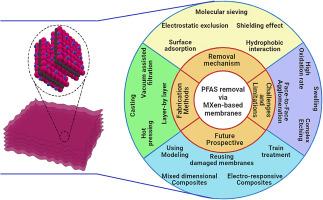Fabrication of MXene-based membranes and their application in per- and polyfluorinated substances removal: Comparison with commercial membranes, challenges, and future improvements
IF 20.3
1区 化学
Q1 CHEMISTRY, INORGANIC & NUCLEAR
引用次数: 0
Abstract
In the past decade, per- and polyfluorinated substances (PFAS) have garnered significant attention due to their widespread presence and detrimental environmental and health impacts. These compounds exhibit exceptional hydrophobicity, oleophobicity, chemical stability, and resistance to biodegradation, posing a significant threat to living organisms, particularly mammals. Numerous technologies have been employed for PFAS removal in which membrane filtration stands out as a highly effective approach, capable of removing different types of PFAS (anionic, cationic, and zwitterionic) with efficiencies exceeding 99 %. The advent of MXenes, a class of two-dimensional transition metal nitrides, oxycarbides, carbonitrides, and carbides, has revolutionized water treatment. MXene-based membranes, with their diverse elemental structure and ability to accommodate multiple surface functional groups, offer exceptional promise for PFAS removal. For the first time, all studies about PFAS removal via MXene-based membranes were summarized in this review article, and their performance was compared to commercial membranes. Moreover, the fabrication methods of MXene-based membranes were discussed in details. Finally, authors have given numerous suggestions about the future of PFAS removal via MXene-based membranes and explained what is missing currently.


基于 MXene 的膜的制造及其在去除全氟和多氟物质中的应用:与商用膜的比较、挑战和未来改进
在过去十年中,全氟和多氟化合物(PFAS)因其广泛存在以及对环境和健康的有害影响而备受关注。这些化合物具有优异的疏水性、疏油性、化学稳定性和抗生物降解性,对生物体,尤其是哺乳动物构成了严重威胁。目前已采用多种技术去除全氟辛烷磺酸,其中膜过滤是一种非常有效的方法,能够去除不同类型的全氟辛烷磺酸(阴离子、阳离子和齐聚物),去除率超过 99%。二维过渡金属氮化物、氧碳化物、碳氮化物和碳化物类 MXenes 的出现给水处理带来了革命性的变化。基于 MXene 的膜具有多样化的元素结构和容纳多种表面官能团的能力,为去除 PFAS 提供了卓越的前景。本综述文章首次总结了通过 MXene 膜去除 PFAS 的所有研究,并将其性能与商用膜进行了比较。此外,还详细讨论了基于 MXene 的膜的制造方法。最后,作者对通过基于 MXene 的膜去除 PFAS 的未来提出了许多建议,并解释了目前的不足之处。
本文章由计算机程序翻译,如有差异,请以英文原文为准。
求助全文
约1分钟内获得全文
求助全文
来源期刊

Coordination Chemistry Reviews
化学-无机化学与核化学
CiteScore
34.30
自引率
5.30%
发文量
457
审稿时长
54 days
期刊介绍:
Coordination Chemistry Reviews offers rapid publication of review articles on current and significant topics in coordination chemistry, encompassing organometallic, supramolecular, theoretical, and bioinorganic chemistry. It also covers catalysis, materials chemistry, and metal-organic frameworks from a coordination chemistry perspective. Reviews summarize recent developments or discuss specific techniques, welcoming contributions from both established and emerging researchers.
The journal releases special issues on timely subjects, including those featuring contributions from specific regions or conferences. Occasional full-length book articles are also featured. Additionally, special volumes cover annual reviews of main group chemistry, transition metal group chemistry, and organometallic chemistry. These comprehensive reviews are vital resources for those engaged in coordination chemistry, further establishing Coordination Chemistry Reviews as a hub for insightful surveys in inorganic and physical inorganic chemistry.
 求助内容:
求助内容: 应助结果提醒方式:
应助结果提醒方式:


